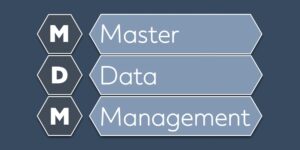
Maximizing AI’s Impact with Master Data Management

(MZStock/Shutterstock)
When data or IT leaders invest in an AI solution, one of their goals is likely to make their organization’s data more actionable and accessible. However, research suggests many employees feel there is room for improvement on this front.
In a recent IDC survey, just 14% of employees said actionable information surfaced “extremely well” in their workflow. Less than one-third (30%) stated such information surfaced in a “very” or “extremely” effective manner as they worked. These figures indicate that most employees see challenges in accessing useful data when and where they need it.
To enable employees to enjoy the benefits of high-quality, accessible data, leaders must improve their data systems and tools — before investing in AI, not after.
Bridging the Gap Between Data and Action
There’s a clear disparity between data expectations and reality. Closing that gap requires a three-pronged strategy focused directly on business user needs:
1. Align Systems to Goals
Develop an intimate understanding of key workflows and user objectives before layering additional data tools or AI. Solving business challenges must remain the priority. Technology for technology’s sake is the enemy of progress.
2. Establish Trust
Ensure data accuracy, security, transparency and relevance. Doing so ensures that users view organizational information as credible and helpful, not untrustworthy and distracting. Quality over quantity is key.
3. Position AI as a copilot
Make AI collaboration seamless by providing systems capable of answering user questions, highlighting patterns, surfacing recommendations within existing interfaces and learning preferences over time. AI technologies should simplify tasks rather than complicate them.
Organizations that emphasize human productivity instead of novel automation can nurture insight-driven cultures in which engaged employees have the solutions they need at their fingertips.
Understand Users’ Current Needs and Use Cases for AI
Master data fuels enterprise AI, but how do employees actually leverage AI day-to-day? Fresh insight comes from a 2,000-person survey conducted by Altair. According to their data, employees most commonly use AI for the following tasks:
- Quality assurance;
- Improving customer experiences;
- Predictive maintenance;
- Supply chain efficiency;
- Product design.
Notably, aside from QA, most use cases directly empower employees or engage customers. And yet, as previously mentioned, only 14% of workers say actionable data fits within their workflow. This startling gap highlights that most organizations must deliver better data—not just additional AI tools—to their teams.
The lesson? AI success depends wholly on quality data accessibility. Data accessibility depends wholly on adopting a viable toolkit, including a master data management (MDM) solution. By raising cross-functional data quality, IT leaders can unlock AI capabilities across the enterprise.
Teams rightfully need help with automating key tasks. An agile, reliable data foundation—as provided by an MDM—allows AI to enhance roles across the enterprise. The employee experience improves through technology made trustworthy and user-centric by design.
Ultimately, AI delivers on its promise only when the fundamentals, like MDM, make self-service analytics and real-time decision-making possible. Worker productivity hinges on correct, connected and clear data. By doubling down on master data first, leaders can unlock frictionless AI.
Building Credibility Through a Phased Approach to AI
Organizations hoping to leverage AI and machine learning (ML) within their MDM strategies face a crucial decision: prioritizing advanced analytics or end-user adoption first. An incremental rollout focused directly on business user productivity carries five distinct advantages:
- It serves the largest stakeholder group (business users) by embedding smart features directly into existing MDM interfaces and data applications.
- It accelerates value creation by enhancing frequently used systems versus investing in emerging or untested capabilities. The priority is solving known challenges faster.
- It limits disruption by working within familiar tools instead of introducing new, unproven ones. Change management remains a barrier to technology deployment, especially for less technical users.
- It reduces risk exposure as external benchmark data —not sensitive internal data — trains statistical models and recommendations. Data governance and ethics remain top of mind.
- It creates opportunities to gain trust and refine long-term strategies by starting small but thinking big. User feedback steers ongoing AI/ML platform evolution.
This “AI copilot” approach allows organizations to serve key stakeholders better while applying lessons learned for future initiatives.
AI and the Enterprise: Reviewing the Path Forward
Today’s data-driven imperative creates intense pressure to adopt AI and modernize infrastructure like MDM rapidly. However, disenchanted leaders know all too well that there are no magic bullets.
Neither flashy AI nor a hastily implemented MDM system alone will make usable insights suddenly pervasive. Instead, leaders must take a more pragmatic path.
First, anchor new solutions directly to demonstrate user needs and establish workflows. Novel capabilities should simplify jobs rather than complicate them. Second, honor people’s duty to exercise judgment amid technology’s possibilities and limits. Trust in AI develops alongside an understanding of its reasoning and mastery of its controls.
Finally, focus less on chasing the shiniest objects and more on strengthening data foundations across teams. Excellence in MDM — though less glamorous — liberates use cases now and in the future.
With clear-eyed restraint and a spirit of human collaboration, organizations can tap into innovative AI technologies while avoiding the hype trapping so many. Remember: Your people want to feel empowered, not overwhelmed. By beginning there, responsible innovation follows.
About the author: Brett Hansen is the Chief Growth Officer for Semarchy. As the CGO, Brett is responsible for go-to-market operations, including marketing, business development, and alliances and partnerships. Before joining Semarchy, he was the CMO at Logi Analytics, which was acquired by Insight Software. He spent 11 years at Dell as an executive leading software product and GTM in Dell Client Group, and prior was with IBM in various marketing and channel leadership positions.
Related Items:
3 Keys to Understanding Master Data Management for Business Leaders, CMOs, and COOs
Master Data Management: Three Paths to Creating a Successful, Low-Risk Program
Is Your Data Management Strategy Ready for AI? 5 Ways to Tell


































